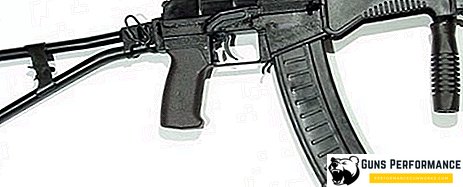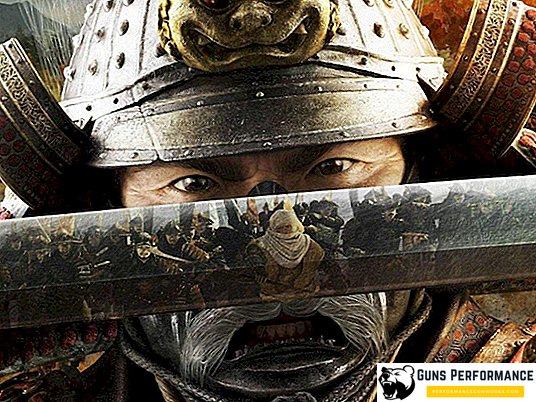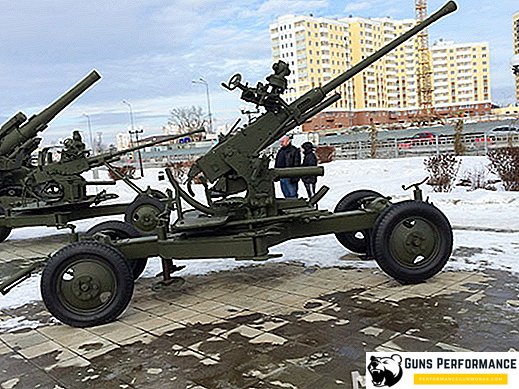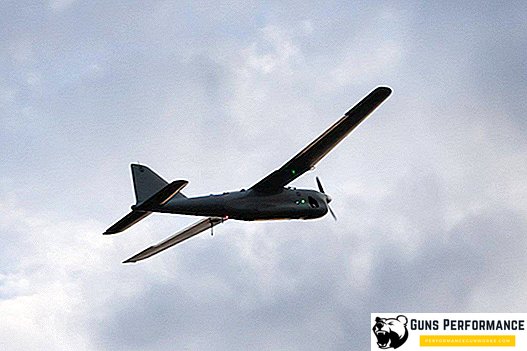"Sukhoi Superjet 100" (English designation similarly - "Sukhoi SuperJet 100") is a short-haul passenger aircraft developed by the closed joint-stock company "Sukhoi Civil Aircraft". Operated from 2011 to the present.
Overview of the layout of the cabin and the location of the best places
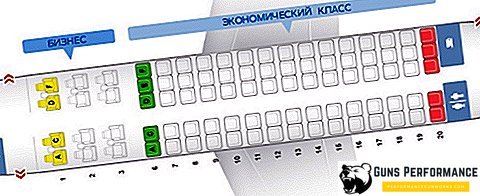
Salon "Superjet" has 87 seats: 12 business class and 75 - economy class. Of course, the most convenient for flying are business class seats, since the seats here are somewhat wider and softer. However, it should be noted that the business class is separated from the noisy economy-class cabin by a rather thin partition, so it will not be possible to completely soundproof the business-class passengers. The very best in business and economy class are the places of the very first row (1st and 6th rows, respectively), so it is desirable to book when buying. Here, no one will throw back the chair in your direction, there is space for the legs. Yes, and being a little further from the noisy middle of the economy class is sometimes very pleasant. After the first-row seats, the best places in the cabin, of course, are the places near the windows (with the letters A and F according to the diagram). The portholes on the plane are large, conveniently located and with a good view.
Not the best choice are the places under the letters C and D. This is because they are located at the very aisle, which is not wide enough. The constant movement of passengers to the toilet or stewards with carts create some inconveniences. The most unsuccessful places in the salon "Sukhoi Superjet 100" are the places in the back row (the whole number is number 20 according to the diagram), in particular places C and D, directly adjacent to the passage. One of the main reasons for this is the regular queues at the toilet. This may cause additional inconvenience.

Aircraft device
Scientifically speaking, the “Dry Superjet 100” (its ICAO designation is SU95) is a turbofan twin-engine low-wing with swept wing and one-fin plumage. The wing profile is supercritical with single-slot flaps (i.e., flaps made in the form of simple rotary flaps). It should be noted that part of the wing mechanisms, as well as its fairings, are usually made of special composite materials, which significantly increases their strength, rigidity and durability.
It is also noteworthy that the designers of the "Superjet" were the first in Russia to use the side control stick of the aircraft ("side stick") instead of the traditional steering wheel. This solution is highly innovative for domestic aircraft manufacturing. Another fairly recent solution is that the aircraft uses an algorithmic protection system that prevents the aircraft from touching the runway, instead of mechanical shock absorbers.
The cost of production of the unit "Dry Superjet 100" is 27 million US dollars (for 2018).

History of creation
The date that initiated the development of the Sukhoi Superjet 100 is considered March 11, 2003, when the expert council of the company called the project PRJ the winner. The development of the aircraft was completed by the beginning of 2006, and in February of the same year, the assembly of the first aircraft with the number 97002 began. Less than a year later, in early 2007, the static tests of the first PRJ started at TsAGI. September 26, 2007 was a presentation of the aircraft.
Tests of the aircraft, as well as its production began in 2008. On February 20, the first race of the Sukhoi Superjet 100 engines was carried out, which gave positive results. On May 14, tests were conducted on the subject of jogging and taxiing on the runway, and on the 19th day the plane made its first flight. In October 2008, the factory tests of the aircraft were fully completed, and the process of certification of the "Superjet" in the International Aviation Committee began. In November of the same year, the life test of the machine began. In June 2009, the aircraft took part in the international air show at Le Bourget.
The beginning of the operation of the aircraft began on April 21, 2011 and continues to the present.
Review of the "SuperJet 100" family
- "Sukhoi Superjet 100" ("Sukhoi SuperJet 100") - the first aircraft of the family "SuperJet 100". As mentioned above, this is a short-haul passenger aircraft with two turbofan engines and a supercritical wing.
- “Sukhoi Superjet 100LR” (“Sukhoi SuperJet-100-95LR”) is a modification of the “Superjet” (LR - Long Range) with an increased flight range (up to 4578 km, the largest among all aircraft of the family) and slightly increased maximum take-off weight. The first flight of the "SuperJet-100-95LR" took place in February 2013. To date, "Sukhoi SuperJet-100-95LR" is also actively exploited.
- The Sukhoi SuperJet-100-95SV Sukhoi Superjet 100SV is a modification of the Superjet with an extended fuselage (SV - Stretched Version). Expected large passenger capacity, as well as take-off weight. The design of the new model began in 2018, the full development is planned to be completed in 2018.
In total, as of April 2018, the number of Superjet planes built was 109, of which 91 were handed over to customers. Among the operators of the Sukhoi Superjet 100 are such countries as Russia, Mexico, Ireland, Armenia, Laos, Indonesia and Thailand.

Flight performance of the SuperJet 100 family:
| Model | SuperJet 100-95 | SuperJet 100-95LR |
| Length | 29.94 m | |
| Height | 10.28 m | |
| Wingspan | 27.80 m | |
| The diameter of the fuselage | 3.24 m | |
| Maximum take-off weight | 45880 kg | 49450 kg |
| Maximum landing weight | 41,000 kg | |
| Maximum payload | 12245 kg | |
| Mass of empty | 24,250 kg | |
| Area of bearing surfaces | 77 m2 | |
| Cruising speed | 830 km / h / 0.78M | |
| Max speed | 860 km / h / 0.81M | |
| Flight altitude | 12200 m / fl400 | |
| Engines | 2 × SaM146-1S17 | 2 × SaM146-1S18 |
| Maximum thrust | 2 × 76.84 kN | 2 × 79.00 kN |
| on takeoff mode | ||
| Range of flight | 3048 km | 4578 km |
| Crew | 2+2 | |
| Passenger capacity | 98 in basic layout (up to 108) | |
| Passenger door | 4 | |
| Luggage compartment volume | 21.7 m3 | |
| Run length | 1731 m | 2052 m |
| Path length | 1630 m | |
| Fuel reserve | 15805 l | |
| Auxiliary power unit | Honeywell RE220 [RJ] | |
| First flight | May 19, 2008 | February 12, 2013 |
Advantages of the aircraft
One of the main advantages of the "Superjet" is the use in its design of the latest technologies and design solutions, which seriously affected its efficiency and reliability. The development of the aircraft took into account the requirements of organizations such as the FAA (Federal Aviation Administration) and EASA (European Aviation Safety Agency), which allowed the "Dry Superjet 100" to be certified in accordance with international standards. It should also be noted that in developing the Superjet, all the wishes of its potential customers (and not only Russian ones) were taken into account and analyzed, which made it possible to adapt it to the future operating conditions to the maximum.
One of the indisputable advantages of this aircraft can be attributed to the fact that for its use the runways of airfields of all classes (A, B and C) are quite suitable. In many ways, this is achieved not only thanks to the design features of the Superjet, but also to the modern avionics system, which, among other things, allows the aircraft to land in difficult meteorological conditions. The cost of a plane ticket is relatively low, which is definitely its serious advantage.
Modifications LR allowed to increase the range of the Sukhoi Superjet 100. And another advantage of the aircraft is its low operational cost, as well as a high level of weight and aerodynamic perfection.
Disadvantages of the aircraft
It is worth noting that the first and main design flaws of the Sukhoi Superjet 100 were identified and eliminated during the testing phase and in the first two years of operation (from 2011 to 2013).
Now the main disadvantages of the aircraft are mainly domestic inconvenience. As noted above, this is not a sufficiently wide passage and some "noise" in the cabin, which creates certain difficulties for passengers in "unsuccessful" places. The disadvantage for the business class is the relatively thin partition that separates this compartment from the economy class.
Nevertheless, it is worth noting that the aircraft has an unprecedented security system, and this, of course, is able to compensate for all the above household noise.

Conclusion
Despite all its flaws, the Sukhoi Superjet 100 is a good aircraft that is suitable for both short-haul flights and long-haul flights (thanks to the LR modification). The cabin, though smaller compared to such giants as the “Airbus A-380,” is nevertheless capacious for this type of car. Effective security system, as well as modern avionics make the aircraft one of the most reliable in its class. Turbofan PowerJet SaM146 (CM146) engines mounted on an aircraft have better efficiency and reliability compared to many analogues. Composite materials used in the manufacture of aircraft wing, provide rigidity and wear resistance of its design. The cost of production of the aircraft compared to competing models of the same class is definitely lower. In short, the “Sukhoi Superjet 100” is really a step towards the passenger planes of the new generation, both in terms of economy, safety and flight performance, which makes it one of the best in its class.


